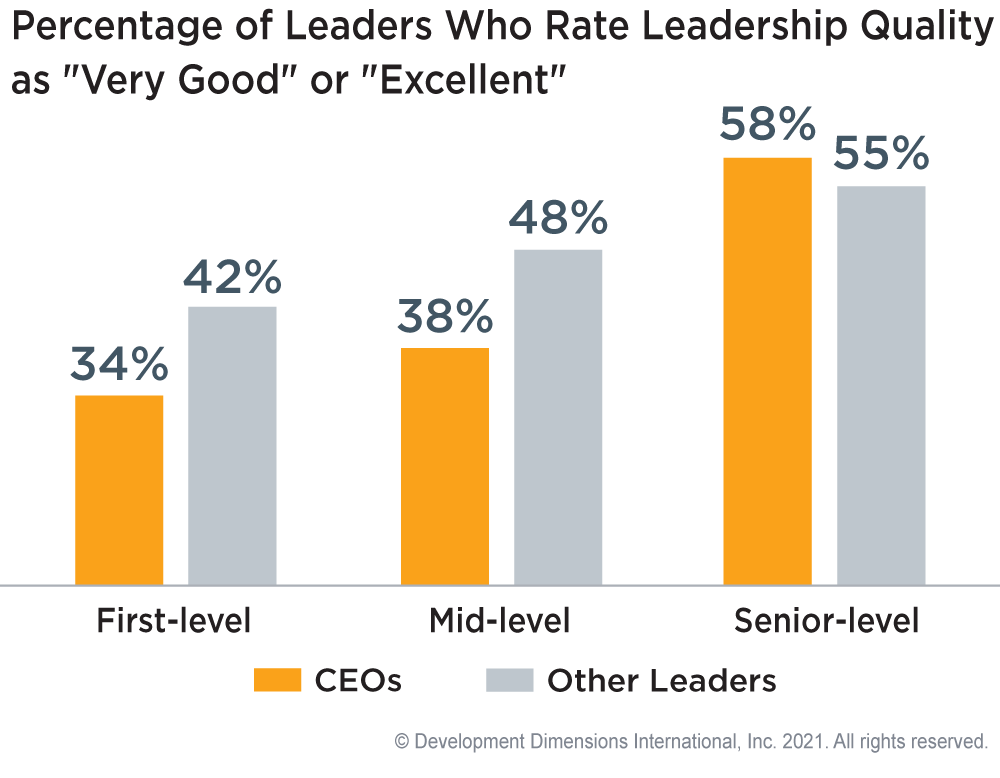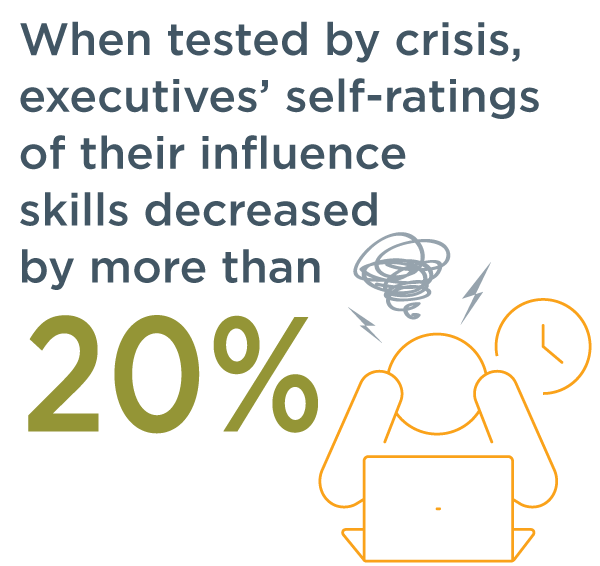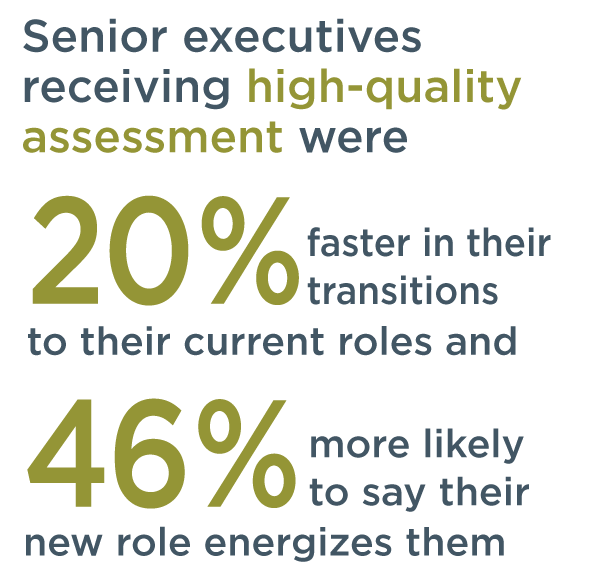CEOs are worried. Managing growth and their performance through tremendous uncertainty while meeting customer and stakeholder needs is no easy feat. But what keeps them awake most at night? According to DDI’s Global Leadership Forecast 2021, one of the top CEO challenges is their people.
What’s Keeping CEOs Up at Night?

New research from the Global Leadership Forecast series highlights a looming gap between future talent needs and the current talent pool of potential leaders. HR ratings revealed that bench strength is at an all-time low, with only 11% of companies saying they have a strong bench. So CEOs’ concerns about having the right people in place for the future are completely justified.
And an even more concerning insight from the new report? Only 14% of leaders across all levels say they are confident in their hiring decisions. This makes it clear there’s a need to help all leaders develop their talent-building skills. Though it’s an urgent skill to develop, the responsibility of preparing for future talent needs is not theirs alone. Leaders need the support of their HR teams to plan talent effectively.
Top CEO Challenges: Many Result from Misalignment
One of the biggest talent issues is that there’s a huge misalignment between HR’s and leaders’ perceptions of their current leadership effectiveness. Organizations are facing the biggest leader quality gap in a decade with 48% of leaders rating leadership as high quality, compared to only 28% of HR professionals.
Often, misalignment at a large scale in organizations is the result of misalignment at the C-level. To explore this issue further, DDI developed the CEO Leadership Report 2021 to research alignment from CEOs’ perspectives and better understand the top CEO challenges and opportunities of C-level leaders.
The report includes responses from 368 CEOs and 2,102 HR executives from around the world to examine how CEOs view their development challenges and those of their organizations. The data revealed four key trends from CEOs, which we’ll be exploring more throughout this blog:
- Top executives expressed concern about the quality of frontline and mid-level leadership quality.
- C-suite leadership quality is dwindling against the rising benchmarks.
- CEOs and executives need more development and support.
- CEOs are not leveraging HR strategically.
Key Trend #1: Frontline and Mid-Level Leadership Is Either Failing or Invisible

When CEOs are asked to rate the effectiveness of their next generation of leaders, their reactions may be disheartening. CEOs lack confidence in lower-level leaders’ capabilities, with only 34% of CEOs rating first-level leader quality as “very good” or “excellent.” And at the mid-level, only 38% of CEOs rate quality as “very good” or “excellent.”
But leaders don’t see themselves and their peers that way. In fact, 42% of leaders reported first-level leader quality is “very good” or “excellent,” and 48% said mid-level leaders were “very good” or “excellent.”
The disparity in ratings between CEOs and other levels in leadership may mean that CEOs are more skeptical of leadership. Their expectations for these leaders may not be clear, and therefore most are falling short.
Or perhaps a more plausible explanation is that C-level leaders simply don’t have enough visibility into lower levels. They don’t know what challenges these leaders are facing, or what they need to be more successful.
This kind of disparity can be dangerous to organizations. We found that having these best practices in place makes it more likely for CEOs to rate their lower-level leaders as high quality:
- Having high-quality internal coaching at all levels. Surprisingly, mid-level and senior leaders aren’t confident in their coaching skills. These higher-level leaders may miss opportunities to coach first-level leaders when they need it most.
- Executing fair and accurate systems for accelerating talent from a diverse talent pool. When the body of leaders is more diverse, leaders are more confident in their organizations’ leadership capabilities.
- Having high-quality leadership development programs in place, curated towards each individual need.
- Leveraging high-quality leadership assessment and feedback programs to identify strengths and weaknesses, which opens up more targeted development.
Key Trend #2: C-Suite Leaders Aren’t Living Up to the High Bar
C-level leaders may be the toughest critics of next-gen leaders, but there are also areas they revealed they could be doing better themselves.
We examined how CEOs rate the effectiveness of their senior leadership teams in relation to their time in their CEO role. Results revealed evidence of a honeymoon period when CEOs first begin their roles. Specifically, new CEOs were 32% more likely to say their senior executives operate as a team effectively compared to those who have been in their role for six months to a year. But more tenured CEOs tend to become disillusioned, increasingly seeing the challenges with their team.
This honeymoon period occurs regardless of whether CEOs were hired externally or promoted internally, showing how universally challenging it is for CEOs to get a read on their new senior team. But objective assessment data can go a long way here. This can either be leveraging already existing talent data, or putting a process in place to assess the senior team.
Among companies that leverage objective data to make their strategic talent decisions, 64% of tenured CEOs rated their senior teams as effective.
Among companies that leverage objective data to make their strategic talent decisions, 64% of tenured CEOs rated their senior teams as effective. That’s more than double the average. But without this kind of objective data, CEOs may hesitate to make any changes to the senior leadership team until it’s too late—after issues arise that may make it harder to recover and execute a successful transition.

Confidence Matters for CEOs
Crisis naturally creates instability, and CEOs are feeling it. When tested by recent crises, CEOs' self-reported confidence dropped by more than 20%. But this confidence drop comes at a time when everyone looks up to leadership for guidance.
Confidence isn’t just about the ego boost for a CEO. It impacts how CEOs operate in key skills as well. When CEO confidence is above average, CEOs are more than twice as likely to be effective influencers and delegators. These two skills are key factors in helping to prevent and mitigate employee burnout.
These areas that CEOs say they can improve upon do not solely impact them alone. Being in the most visible role in organizations means these gaps may leave lasting impacts on their organizations.
When CEOs are confident in their abilities, others are confident in them too. This can help improve leadership effectiveness ratings. When perceptions of leadership effectiveness are high, leaders at all levels of the organization are more than twice as likely to be engaged in their roles. They are also 1.5 times more likely to find their work full of meaning and purpose.
Leveraging assessments helps CEOs in these key areas. By having their senior leadership team members complete high-quality assessments, the CEO can quickly gain an objective perspective of strengths and development areas of their teams. This can allow them to make decisions about having the right senior leadership team in place more quickly.
Assessments can also be leveraged to identify CEO strength and opportunity areas. They can work with an executive coach to get more individualized opportunities to improve specific behaviors. This type of development may help them with confidence during times of crisis. Gaining an external perspective may be helpful during uncertain times.

Key Trend #3: Who’s Accountable for Executive Development?
CEOs typically have extensive experience in leadership before assuming their roles in the C-suite. This is what feeds the perception that CEOs always have the right answer. And this could be flattering for leaders at the C-level. But this could also be damaging in that many CEOs may feel they need to have all the answers.
The CEO Leadership Report 2021 indicated that CEOs are also susceptible to vulnerabilities but are often left on their own when transitioning into their roles. They are less likely to have a formal coach or mentor to help them transition. They are also less likely to receive leadership training for their new roles than first-time business leaders. But when they do receive transition support in the form of high-quality assessments, CEOs transition into their roles 20% faster.
In addition to assessments, 60% of CEOs want more external coaching and feedback to help them improve their leadership skills. CEOs receiving high-quality assessment and feedback were eight times more effective at hiring the right people and six times more likely to foster an inclusive culture in their workplace.
It’s clear that CEOs fortunate enough to receive external coaching and feedback have a much more positive impact on their organization’s talent. Furthermore, when CEOs receive formal leadership training in areas where they struggle, they are 1.6 times more likely to be in the top 5% of financial performers compared to those without this training.
The challenge is that only some CEOs are going to ask for development. But that doesn’t let boards of directors and CHROs off the hook. Boards and CHROs should be regularly working with the CEO on their development, whether they ask for it or not.
Key Trend #4: CEOs Are Not Leveraging HR Strategically
It’s no question that CEOs have a lot of pressure to be effective in their roles. They are setting the future direction of their organizations to help maintain a competitive advantage. A big part of their success in implementing this direction is having the right talent to help bring things to life.
CEOs are not alone in this struggle. HR is there to help, though many organizations have misalignment between the CEO and the CHRO. For example, we found that only 47% of CHROs and CEOs from the same company aligned on their perspectives of senior leadership quality. Lack of alignment makes developing and implementing a talent strategy even more of a challenge.
In addition to misalignment, the role of the CHRO and the HR team has important implications for strategic success. In many cases, CEOs only use their CHROs and HR teams as “reactors” who simply execute on talent needs. But in high-performing organizations, CEOs leverage HR more as “anticipators,” meaning that HR and the CEO are working side by side to use advanced analytics to align the company’s people strategy and business strategy, anticipating and filling talent gaps before they happen.
This kind of relationship between the CEO and HR makes a huge difference. When the CHRO is an “anticipator,” their organization is three times as likely to hire the right people and twice as likely to be in the top 10% of high-performing companies.
When CEOs work closely with their CHROs and empower them to be more strategic, everyone wins. This alignment can be felt throughout other levels in the organization as the right talent is in the right place to work towards strategic objectives.
In Conclusion:
Is There a Crisis of Leadership Ahead?
These top CEO challenges are being faced at a time marked by unprecedented pressures. With the lack of bench strength and talent shortages, organizations are at risk for a leadership crisis. How they manage this looming crisis will define their success, and the future success of their business.
The biggest mistake CEOs may make will be to move too fast and neglect key developmental opportunities that could help them and their leadership teams achieve success. Doing so will put their organizations at risk for not being able to meet strategic goals or maintain core operations effectively in the future.
All development can’t happen on the job. Leveraging external resources such as assessments and coaching can help provide objective perspectives on how to improve and tackle uncertain situations. These external solutions provide a huge advantage in that they do not necessarily follow the same paths as internal development opportunities do.
Leaders have considerable influence in driving future business results through an engaged and empowered team. Knowing this, organizations can provide support and develop leaders to create a stronger culture. They can also help managers become great coaches and inspire senior leaders to drive lasting change. In short, leadership at all levels matters and it starts with alignment in the C-suite.
To get more research and best practices, download DDI’s CEO Leadership Report.
Rosey Rhyne is a senior research manager on DDI’s Center for Analytics and Behavioral Research (CABER) team. With a background in HR, Rosey is passionate about uncovering opportunities to improve the leadership and employee experience.
Stephanie Neal is director of the Center for Analytics and Behavioral Research (CABER). She leads market and trend research focused on leadership and business innovation, and is general manager and lead author of DDI's Global Leadership Forecast.
Topics covered in this blog

